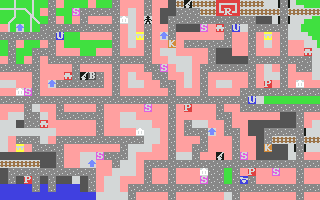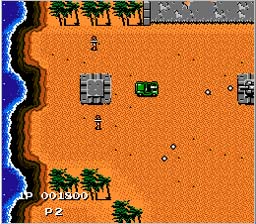Actually, looking at those screens for 1942, I'd be amiss if I didn't add to my previous mention of Wizardry 1 and Ultima 2, the arcade classics that I played for years: especially Double Dragon. Fuck that game had a long shelf-life. In those days, as far as I knew, playing computer games at home meant playing with near-ASCII (Ultima 2's static sprites weren't a huge step up from ASCII - to make a comparison, it came out BEFORE Rogue had its commercial release) ie 3-d-line-graphics (ala Wiz 1), and the only games worth playing with those graphics were rpgs. You might not have been able to see a character walk in Ultima 2, but you could have a world that contained each continent as they are today, as they were when joined together as patagonia, as they were during the middle ages, then the future, then the 'aftermath' (after Minax destroyed everything - you can go there surprisingly early, it's supposed to be a motivation for you having to stop Minax), with numerous time-gates (some one-way, some both-ways) leading between them, dungeons ala the wizardry games contained therein, different cities, towns and villages with the NPCs and stores available varying on the size and location of the town, as well as planes, ships and rockets (leading to things like heading to 'current-era', stealing a plane, then flying it through a time-portal to the past to get to a bit you couldn't get to before, etc. Oh, and all the other planets in the solar system accessible by rocket, plus a hidden one or two. OK, the game sucks if you play it now (so I'm told), but back then U2 was mindblowing and it showed how you could create an incredibly large and varied world with next to no graphics.
But for games that actually had, you know, colour, and moving sprites, you needed to go with your friends to the arcade. The era of co-op (which actually disappeared for about 10 years between the arcade and console eras). Places like 'Timezone' and equivalent arcades were cram packed with kids lining up for each game, and about 70% of them would be kids who had run out of coins but were happily watching some other kid play so they could learn tricks of him (I say him, because arcade games were pretty much a male-only thing). 10year old birthday parties were often held at gaming arcades, and I remember my best few friends and I would occasionally get shouted to a 'lock-in' session for doing well at school, where you'd pay 10 dollars a kid at 9am and then have ALL the games set to infinite credit-mode until 2pm that day. That was the shite

They'd often have rules limitting how many replays you could have on a game until the next kid got to have a go (though they'd manage the bookings so there's be less kids than games available, so you didn't have to wait to play - only if you were waiting to playing the high-demand games kike Double Dragon, or Rumble).
Anyway, Double Dragon ruled the roost. It was the first game I'd encountered that had the difficulty perfect for its market. It had a time limit that required efficiency, but unlike the many games that followed, the time limit WAS achievable on 1 credit, so it didn't act as a 'hahaha put more money in you chump' barrier. Similarly, on an average 1st playthrough by kids familiar with the beat-em-ups of the era, you'd make it to about the 1st boss (the giants in the carpark), maybe halfway to the 2nd guy (the guy that looks like a green version of you, with the same moves that you fight on top of the industrial lift, where you can fall off). After you started to get good, you'd start having to put in more coins sometime through forest part, usually for losing a stupid life by screwing up the jump across the bridge, and often losing multiple credits to the badass black giant who waits on the other side of the bridge. Was still value for money, as you would still get a decent amount of further gaming in due to it being an early employer of the 'easy bit, harder bit, boss, easy bit...etc' pacing rather than the 'let's get increasingly fast and difficult so that anyone stupid enough to put more coins in will lose them in 15 seconds' that games like kung fu master had made popular. Once you got 'genuinely good' by my friends' 10 year old standards, you'l nail that bridge guy easily, because one of you would have kept the knife from a previous fight and throw that at him from across the bridge, and one of you would still have a baseball bat. Well, and by that time you'd have worked out that 'elbow beats everything', except when you're low on time.
A genuinely good player would also be able to beat the last of the uber-badass giant black guys that fights you near the cliff at the entrance to the base. As long as you didn't let him throw you over the edge he was fine - his strength was also his weakness - tons of boulders lying around that you could throw at him, just dodge when he throught them at you, and you never needed to go toe to toe with him.
Then the fucking hardest part in the game - the random crushing-walls-of-death that would kill you instantly and unfairly. Worst part of the game, and so naturally the one that all future arcade beat-em-ups copied. Then the awesome fight against the machine-gun guy. Nearly impossible in single-player, but if you worked together you could hammer him, as he only shoots in one direction per clip, so one guy stays offline while the other takes him out.
Then the awesome-est part - in DD if both players survived, you got to fight each other at the end to decide who wins. This was well before street fighter, and it was the first game that I remember having a PvP section.
I remember that by the end of the arcade era, a couple of friends and I could clock DD on 1 credit, and it was all about who won that final fight, everything else was just to make sure you had spare lives to give an advantage in the last bit - including the use of 'accidental' friendly fire to loosen up your opponent in the last few sections (sry, I didn't mean to swing the baseball bat in your direction as you were jumping past the wall-of-death bit! Really!)
People blame consoles for ending the arcade era, but that's only partially true. Greedy fucking arcade managers had a lot to do with it. DD stands out not just for being a good game, but for being the last of its kind. I.e. the last casual arcade game where you didn't either have to:
(a) learn bizarre button combos that were hidden from the player (for years after SF2 and those games first came out, the instructions would tell you maybe 1 or 2 combos for 1 character, and that there were others to discover). Hidden combos are awesome and all, but not when the game is only effectively playable if you already know them, AND you're learning on your own credits. Think of it...pre-internet as well and pre-home-console - you'd be going: 'hmmmm, how do I do Chun Li's spinning kick thingy?...down and left button? no. down and right button, no. Oh well, pay another sixty cents. Down and up? no. Down, up, right button?. No, pay for another credit. Down, right, left button?. no. Another credit...' Yeah, real fun that was! Compare that to the DD hidden combos: push away and punch - elbow. Push away and kick - flying kick. keep tapping punch - headlock and knee combinations. They weren't just simpler - they were things that you'd be doing ANYWAY just while playing, and so you'd discover all of them by accident within about 2 or 3 credits. Whether it was the arcade owners that deliberate removed instructions that were supposed to come with the game (and did in later editions), or just developer shortsighteness, by the time that problem was fixed, people had stopped playing in arcades and the home console era had begun - even though at that time the home consoles were nowhere near as good as the arcade versions.
(b) use more than 1 credit to win the game, no matter how good you were. It was done many ways - impossible time limits, unavoidable death traps, absurdly ramping up the speed of enemies after a certain point. But DD2 and DD3 did it the worst - making you pay extra credits in order to 'buy' extra moves. The implication being that there's no point playing the game unless you're going to spend 3 credits at once, because otherwise you're gimping yourself - and then you still ran into 'absurd time limit' barriers anyway.
But yeah, Double Dragon should sit with U2 and Wiz1 as my 'what-made-me-a-gamer' games.
And completely to the opposite - Doom made me a modern gamer. That was the first home game that wasn't an adventure game or an rpg that I had bought since I stopped playing my old C64. It was also what rekindled my interest in games after a long break where I had decided I just didn't have time to finish my old copy of Bards Tale 3 anymore. If only I had known what games like Doom would have done to the games I grew up with:-(




















![Glory to Codexia! [2012] Codex 2012](/forums/smiles/campaign_tags/campaign_slushfund2012.png)



![The Year of Incline [2014] Codex 2014](/forums/smiles/campaign_tags/campaign_incline2014.png)










